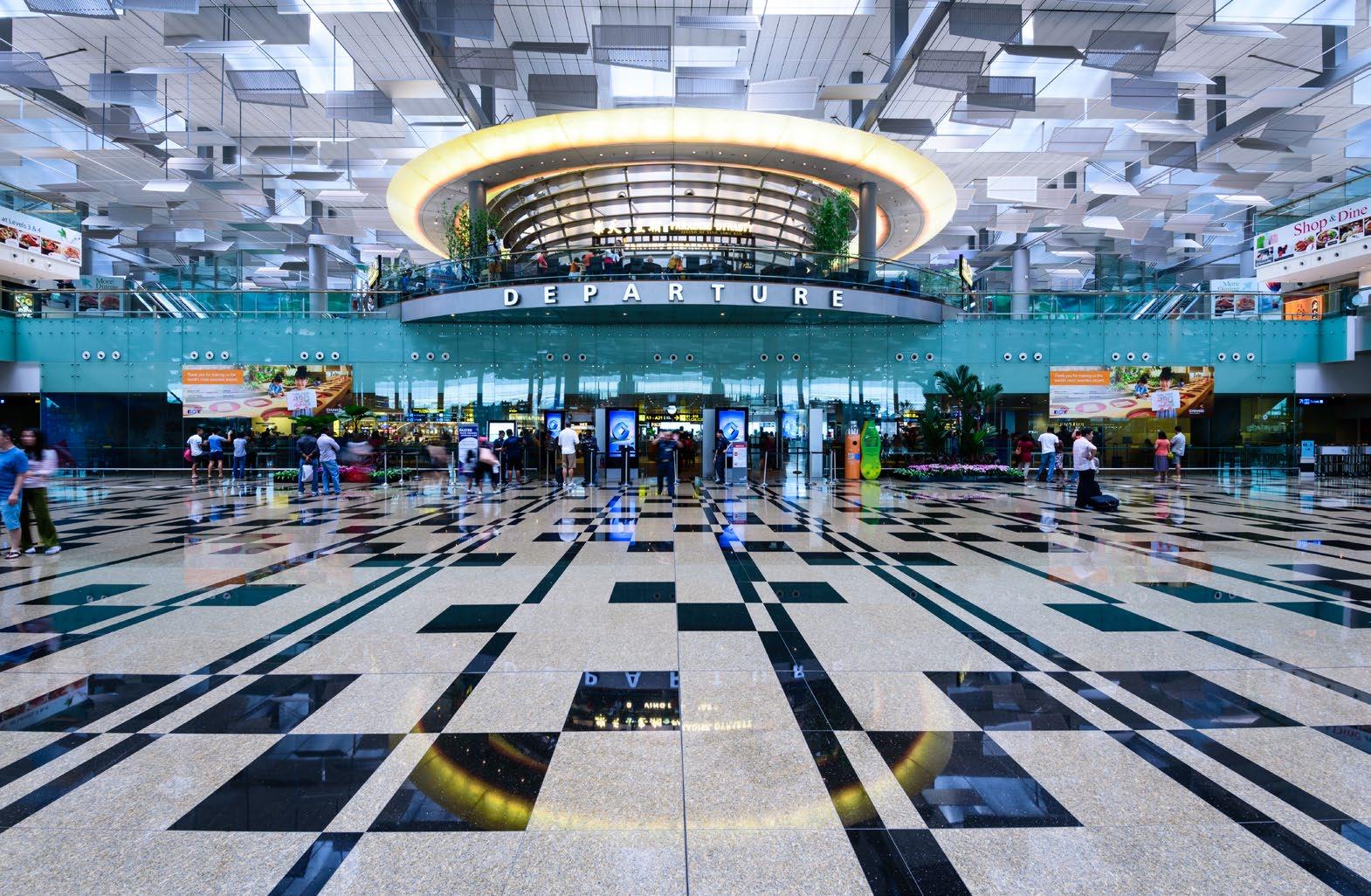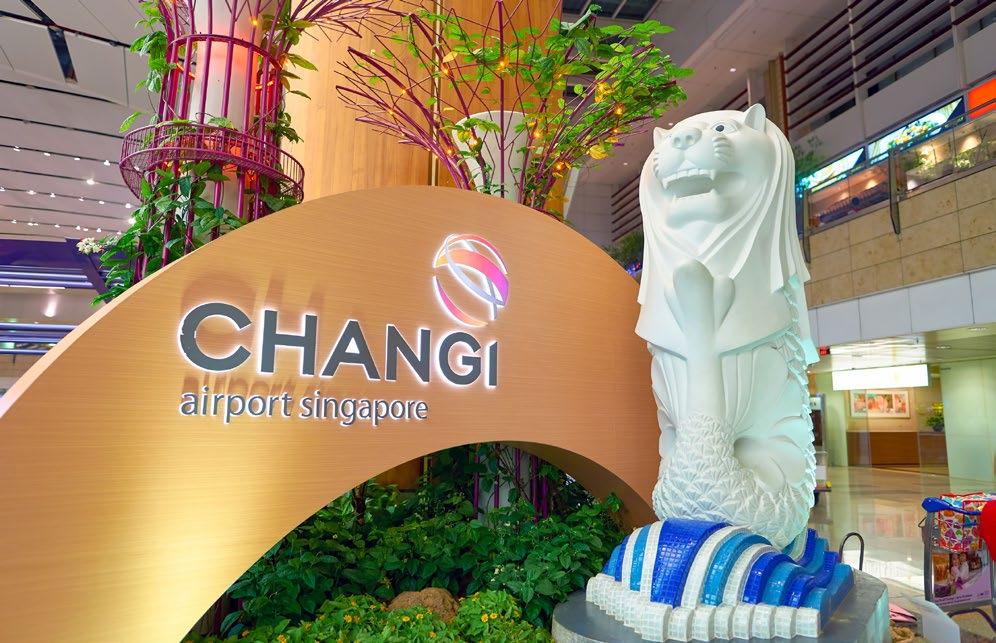






“The word summing up aviation in Singapore in 2022 is, without a doubt, recovery, with Changi Airport finishing the year top of the Asia-Pacific.”

As at mid-December, its weekly passenger numbers had reached 75 per cent of those pre-Covid-19, a day-and-night comparison with March’s 18 per cent when borders here and in the region had yet to open.
All four of Changi Airport’s terminals are now also reopened and processing steady streams of passengers. The high-profile
reopening of Terminal 4 in September and the southern wing of Terminal 2 in October has returned the airport’s handling capacity to 70 million people a year, in time for the year-end holidays.
The year 2022 has been one of strong recovery for Changi Airport. With the relaxation of travel restrictions in April, Changi Airport has seen passenger and flight movements rise steadily through the months. While only Terminals 1 (T1) and 3 (T3) were serving passengers at the start of the year, Changi reopened Terminal 4 (T4) in September and the southern wing of Terminal 2 (T2) in October, to cater to the surge in both outbound and inbound travel demand.
In tandem, travel retail sales have also seen a revival, with Liquor, Perfumes & Cosmetics, and luxury products once again emerging as the top categories in Changi’s stores to date. At the landside, all the shops in T1 and T3 are open to welcome both travellers and visitors. At the same time, Jewel Changi Airport has continuously refreshed its offerings, with both homegrown
and international brands setting up shop at the nature-infused attraction.
To handle the strong uptick in passengers and flights, the various organisations within the airport community have actively ramped up their manpower and staff training.
Throughout the pandemic, they have worked closely with and supported one another to persevere through the challenging Covid-19 period, while continuing to uphold the high service levels that Changi has worked hard to build. For its continuous pursuit of service excellence to offer the best Changi Experience to passengers, Changi Airport was presented the Best Airport Staff award by Skytrax for the second year running. Including this award, Changi Airport has garnered a total of 655 awards since its inception, making it the most awarded airport in the world.
In the first 10 months of 2022, Changi Airport saw 23.6 million passenger movements, representing 42% of pre-Covid-19 levels. Aircraft movements, which include landings and takeoffs, totalled about 170,000, 53% of pre-Covid-19 levels.
For the month of October 2022, Changi Airport handled 3.69 million passenger movements, representing about 65% of that handled in October 2019. Some 21,800 aircraft movements were registered in the same month, about 68% of that registered in October 2019.
As at the first week of December 2022, 95 airlines operate over 5,500 weekly scheduled flights at Changi Airport, connecting Singapore to some 140 cities in 48 countries and territories worldwide. This is 82% of Changi’s pre-Covid-19 connectivity.
In 2022, Changi Airport welcomed eight new airlines. There is a mix of full-service and low-cost carriers as well as freighter operators - Aircalin, Atlas Air, Bamboo Airways, Cambodia Airways, Citilink, HK Express, Thai Vietjet and T’way Air. We also added four new destinations to our network – Noumea (New Caledonia), Jeju (South Korea), Pune (India) and Sibu (Malaysia).
For the first 10 months of the year, Changi’s top five country markets were Australia, India, Indonesia, Malaysia and Thailand. However, the strongest passenger traffic recovery has come from the regions of North America, South Asia, and Europe.
Passenger traffic to and from North America has rebounded strongly to exceed pre-pandemic levels. For the South Asia market, apart from re-establishing all pre-Covid city links, Changi also added a new city link to Pune on 2 December 2022. For Europe, Changi has almost returned to pre-Covid level of flight frequencies.
On the cargo front, Changi Airport registered more than 1.5 million tonnes of air cargo throughput from January to October. Its top five air cargo markets for the first 10 months of the year were Australia, China, Hong Kong, Japan and United States of America.
In August 2022, they welcomed the partnership between DHL Express and Singapore Airlines to operate five Boeing 777 freighters out of
Changi Airport, which will fly on routes between the United States and Singapore via points in North Asia and Australia.
Notwithstanding near-term challenges such as global economic uncertainty and inflationary pressures, air cargo continues to be a bright spot for Changi Airport as it remains steadfast in its mission to facilitate global trade and support the flow of essential goods, including medical supplies, into Singapore and onwards to the surrounding region.
Our continued quest to strengthen Changi Airport’s cargo handling capabilities and building connectivity has garnered industry recognition.
Changi Airport won the “Best Airport – Asia (Over 1million tonnes)” award at the recent 2022 Asian Freight Logistics and Supply Chain (AFLAS) Awards. The awards, hosted and organised annually by Asia Cargo News, recognise leading service providers and associated industry professionals.
Changi Airport also received commendation by the panel of judges for the “Cargo Hub of the Year” and “Air Cargo Pharma Award” category at the Air Cargo News Awards 2022. The “Global Airport of the Year” award was also presented to Changi Airport at the 9th Payload Asia Awards, which recognise industry leaders and trendsetters of the air cargo and logistics supply chain who stay at the forefront of innovations.

In June 2022, Firefly reinstated its services to Seletar Airport from Sultan Abdul Aziz Shah Airport, Subang, Malaysia, a significant milestone for the recovery of air services from the Covid-19 pandemic. With the resumption of scheduled flights, the airline now operates six daily Kuala Lumpur - Singapore services between Sultan Abdul Aziz Shah Airport and Seletar Airport.
To facilitate the strong pickup in travel demand, Changi Airport progressively reopened T2’s Arrival Hall in late May, followed by T4 in September and the southern wing of T2’s Departure Hall in October. Ahead of the terminal reopening, multiple operational readiness tests involving thousands of participants from different airport partners were carried out to test various systems and processes, to ensure that all the terminals reopened smoothly.
Today, Changi Airport has capacity to handle more than 70 million passenger movements a year. This exceeds the 68.3 million passenger movements of 2019.
In tandem, the various airport organisations have been actively recruiting more staff to ramp up their operational capacity to handle more flights and more passengers. The aviation sector in Singapore has been organising job fairs and other activities to bring in more workers to meet the demands generated by the air travel recovery. Since the start of the year, over 6,000 new workers have joined the aviation industry.
In February, Changi Airport launched new initiatives to better support passengers with invisible disabilities, such as autism spectrum disorder, Down syndrome, and dementia. Aimed at creating a more stress-free and inclusive travel experience for these passengers, the initiatives include a customisable step-by-step airport guide (Changi Airport Social Story), having a pool of staff trained in identifying
passenger with invisible disabilities, and being alert to special identifying lanyards, so these passengers can get help more easily and discreetly. The initiatives were developed by CAG in consultation with special needs schools and organisations.
With the increase in passenger traffic, Changi Airport’s wellloved facilities such as the Butterfly Garden in T3 and Sunflower Garden in T2 also reopened to delight passengers.
With the reopening of T2, all the Skytrain services in the public areas also resumed service, bringing convenience to visitors and joy to airport fans who frequent the airport as their weekend family haunt.
Over at the airside, Changi Airport introduced a new runway condition reporting system which can automatically assess and relay any change in runway surface characteristics to air traffic controllers and pilots in real-time, in line with the latest requirements of the International Civil Aviation Organization (ICAO). This involves the use of sensors to continuously monitor the level of running or standing water on the runway surface during wet weather, and broadcasting it to air traffic controllers so that they are more aware of environmental factors of operational significance. Pilots can also make use of the information provided to better control aircraft take-off and landing performance.
With the recent resumption of operations in T2 and T4, shops will re-open progressively in the upcoming months in tandem with passenger traffic recovery.
The surge in travel demand at Changi is leading to a revival in travel retail sales at the airport.

The most popular product categories are Liquor, Perfumes & Cosmetics, and luxury products. Even with Chinese tourists, who were the biggest spenders during pre-Covid days, still absent from the travel retail scene in Changi, some brands are seeing sales surging past pre-pandemic levels.
From end-September to the year’s end, CAG is running its inaugural World of Wines and Spirits (WOWS) in partnership with Lotte Duty Free, bringing Changi’s duty-free offerings to another level. WOWS showcases the world’s most internationally acclaimed, exclusive and premium wines and spirits, featuring over 200 of the finest products from more than 75 brands, including first-in-the-region rarities from renowned labels like Bowmore, The Macallan, Midleton, The Singleton and Penfolds.
Besides themed holiday activations such as Chupa Chups and Peanuts in March and May respectively, the airport also rolled out various dining promotions and shopping campaigns during festive periods to drive sales to support tenants
operating in the airport’s public areas.
Changi Airport Group (CAG) is committed to advancing Changi Airport as a sustainable air hub. Besides committing to zero carbon growth until 2030 and capping absolute carbon emissions at 2018 levels, CAG strives towards a Net Zero aspiration by 2050 through the use of new technologies and the increased adoption of renewable energy. To power more sustainable air travel, CAG also supports green initiatives by airport partners, including the adoption of Sustainable Aviation Fuel by airlines operating at Changi.
In addition to reducing carbon emissions, CAG continues to reduce overall water consumption, as well as optimises waste management by encouraging good recycling practices and implementing effective waste collection systems.
The new passenger Terminal 5 (T5) is being developed at Changi International Airport in Singapore to enhance the airport’s capacity to meet
anticipated future growth. The new terminal is set to be one of the world’s biggest airport terminals.
Estimated to cost approximately $10bn, the project marks the biggest expansion at Changi Airport to date. It is part of Changi East development, which also includes the development of a three-runway system and network of inter and intraterminal tunnels.
The single integrated terminal will be bigger than the existing terminals at the airport. It will be built on a 1,080ha greenfield site located to the east of the airport.
Land preparation works at the Changi East began in 2014 and continued until 2020. Design and engineering works of the Terminal 5 project are currently underway. Construction on the T5 is expected to begin in the 2020s, with completion scheduled for the 2030s.
T5 will be able to handle up to 50 million passengers a year in the initial phase of operation, increasing the airport’s total
annual passenger handling capacity to 135 million.
The landside and airside facilities of Changi Airport’s Terminal 5 will include main terminal building, satellite terminal building, ground transportation centre, cargo complex, primary landside roadway, taxiways, aircraft parking stands, and other supporting aviation infrastructure.
The project also includes the development of aircraft maintenance, repair and overhaul (MRO) facilities, roadway and drainage systems, and establishing connections for utilities such as power, gas, fuel, water, and telecommunications to the T5 building.
An 18km-long network of tunnels will be built to establish airside connections within T5, as well as between T5 and existing
terminals 1, 2, 3 and 4 at the airport. The tunnels will allow for convenient movement of baggage, passengers and airside vehicles.
CAG appointed a group of companies to deliver the Changi airport master plan, airfield and engineering design, consultancy services and functional design review of Terminal 5 in April 2018.
A consortium of Heatherwick Studio, KPF (Singapore), and Architects 61 will provide architectural design services for the landside works.
A consortium of Surbana Jurong Consultants, Arup Singapore and Mott MacDonald Singapore was selected to provide engineering and consultancy services, while DP Architects is responsible for the design of commercial spaces in
the T5.
Changi Airport Planners and Engineers (CAPE) along with Arup, Mott MacDonald, and Surbana Jurong will provide programme management and civil consultancy services for the landside and airfield works.
Design consultants for the Terminal 5 project include Speirs + Major, James Corner Field Operations, Lichtvision Design, The Fountain Workshop, Bruce Mau Design and Entro.
Dornier Consulting International performed a strategic review of various issues related to the Terminal 5 development including the terminal, airfield, and cargo / industrial zone.



In your own words, please give me an overview of Avis.
Avis is a leading provider of car rental services and mobility solutions. The company was established in 1946 and has since expanded to over 11,000 locations in 180 countries. Avis is an innovative and technologyled company operating globally in mobility, offering a wide range of car rental options through its distinct brands. Avis is a premium brand that caters to sophisticated, quality-seeking customers who are willing to pay more for a superior rental experience. Avis is always trying to do better through innovation and service that improves the car rental experience for customers.
Avis’s values are customerled, ownership, inclusion, integrity, and innovation. The company is committed to honouring its commitments to its employees, customers, and shareholders by living these values and creating a supportive and respectful environment for all. The company provides exceptional service and a stress-free rental experience to its customers while valuing health and wellness for all involved; we are “driven by better”.
With a focus on acting with integrity, trust, and honesty in all dealings, Avis provides its customers with a fair and
transparent rental experience, while its employees are valued and recognized for their hard work and dedication.
At Avis, we maintain our commitment to excellence and ensure that our customer satisfaction sets us apart from our competitors in the rental vehicle industry. Our premium car rental services offer a refreshing change to customers looking for a superior rental experience from a complimentary cold water bottle on a hot day, to a personalised welcome when you check-out.
How many offices and how many employees are there at the company?
With a team of 20 team in Singapore, we are conveniently located at Changi Airport, where we have rental counters at both Terminal 2 and Terminal 3 arrival halls. We have reopened our operation in T2 in March 2023. This will provide our customers with enhanced flexibility in selecting their desired pick-up location. To cater for our local clients, we also operate from our downtown office located on Havelock Road. As the pandemic eases, more people are travelling to Singapore. Some drawn by its mix of culture, cuisine, and modern attractions, others for business but there is something for everyone.
When did Avis Singapore first come to Asia?
Avis first entered the Singapore market in the 1970s and has since established a strong presence in the country as a leading provider of car rental services. The company has several counters in the country, making it convenient for customers to access its services, and offers a wide range of vehicles to meet the needs of both personal and business travellers.
Avis still operates strongly even after the incredibly difficult period at the height of the COVID-19 pandemic. This is testament to our strength and determination to offer a high-quality services and vehicles.
Avis is committed to providing exceptional customer service and has received numerous awards for its customer-centric approach. Avis has made a significant investment in the Singapore market through its recent vehicle acquisitions and continues to play a significant role in the country’s transportation industry. With its commitment to providing innovative and sustainable solutions, Avis is well positioned to continue its success in Singapore in the years to come.
Since starting, how has Avis Singapore performed and grown?
Since entering the Singapore market, Avis has established itself as
a leading provider of car rental services and mobility solutions. Over the years, the company has seen steady growth in both the personal and business segments, thanks to its commitment to providing exceptional customer service and innovative technology.
Avis Singapore has expanded its fleet of vehicles to meet the changing needs of its customers, offering a wide range of options from economy cars to luxury vehicles. The company has also embraced new technologies, such as a new website with improved booking engine to streamline the rental process and make it more convenient for customers to rent our vehicles.
Overall, Avis Singapore has performed exceptionally well since its inception. Consistently delivering strong financial results, we have earned recognition as a leading player in the local and global markets. The company’s commitment to innovation and customer service has helped it to stay ahead of the curve and set it up for continued success in the future.
What role does training and recruitment play at the company?
Our team are crucial to the success of our company; by executing their tasks and responsibilities efficiently and with passion, they enable us to reach our company objectives. Our team are highly trained and live by our company mantra: ‘Driven by Better’. Our team also contribute to the company culture, adapt well to company changes and work collectively to reach our company goals. We collaborate on tasks and share communications to inspire and engage our employees.
Qualities we look for when recruiting new talent are knowledge/ experience in a relevant field, integrity, and ambition. Our internal culture celebrates the diversity in our people by spreading awareness of diverse cultures and events; we share real stories about our employees as guiding lights for our culture. At Avis, we are inclusive and constantly strive to bring new social activities and opportunities to our team.
To ensure quality of the highest standards what measures have been taken?
To ensure the highest standards, we have taken several measures, including:
1. Employee training: We invest heavily in training our employees to ensure that they are equipped with the skills and knowledge needed to provide outstanding customer service. This includes regular training sessions on customer service best practices, product knowledge, and technology.
2. Customer feedback: We actively seek and listen to customer feedback to understand what we are doing well and where we can improve. This feedback is used to make datadriven improvements to our services and to ensure that we are meeting the needs of our customers.
3. Quality control processes: We have established rigorous quality control processes to monitor and improve the quality of our services. This includes regular inspections of our vehicles, customer service evaluations, and audits of our operations.
4. Investment in technology: We are committed to using technology to improve our services and provide a more seamless experience for our customers. We invest in new technology solutions, such as an improved online booking platform and digital check-out services, to make it easier for customers to rent our cars and to streamline our operations.
5. Sustainability efforts: We are committed to reducing our environmental footprint and promoting sustainable practices. This includes investing in energy-efficient vehicles, etc.
By taking these measures and continually seeking to improve, we are confident that
we are delivering quality services of the highest standards to our customers. We are proud of the work that we do and are committed to maintaining our high standards into the future.
How do you better the environment? Do you have strategies in place to reduce your carbon footprint?
We have several strategies in place to reduce our carbon footprint, including:
1. Fleet management: We are continually upgrading our fleet to include more energy-efficient vehicles and vehicles with alternative fuel options. This helps to reduce the emissions produced by our vehicles and to promote cleaner, more sustainable transportation.
2. Sustainable operations: We are committed to reducing our carbon footprint through sustainable operations. This includes reducing energy consumption and minimizing waste. We “reuse, reduce and recycle” all that we can.
3. Employee engagement: We engage our employees in our sustainability efforts and encourage them to take an active role in reducing our environmental impact. This includes promoting sustainable practices such as reducing energy consumption in the workplace.
4. Collaboration with partners: We work with our partners, such as suppliers and rental locations, to promote sustainable practices and reduce our environmental impact. This includes promoting energy-efficient products, implementing recycling programs, and promoting alternative transportation options.
5. Investment in Technology: We’ve shifting towards the digital world. Invoices are sent and retrieved online instead of printing physical and unnecessary paper. In the near future, we are investing in technology to further speed up the customer journey – our aim is to get our customers on the road as quickly as we can.
These strategies are just a few of the ways that we are working to reduce our carbon footprint and promote sustainable practices. We are committed to continuously improving our environmental performance and to doing our part to protect the planet for future generations.
What about safety, how important is this to Avis Singapore?
Safety is of utmost importance to our company. Notwithstanding the expected Health and Safety standards of today, we have also pledged our safety standards to our customers about the cars we send out in a COVID-19 related environment.
We understand that our customers entrust us with their safety when they rent our vehicles, and we take this responsibility very seriously. We have implemented strict safety measures to ensure that our customers have a safe and stress-free rental experience. Our vehicles undergo regular maintenance and safety checks, and we follow all government regulations and guidelines to ensure compliance with safety standards. In addition, we have implemented a comprehensive cleaning protocol to ensure that our vehicles are thoroughly cleaned between rentals. We also provide our customers with safety information and guidelines to promote safe driving practices.
Furthermore, our team is committed to providing exceptional customer service and assistance to ensure that our customers have a safe and comfortable rental experience. We are always available to answer any questions or concerns our customers may
have, and we work tirelessly to maintain our reputation as a trusted and reliable rental service provider.
In short, safety is a top priority for Avis Singapore, and we are committed to providing our customers with a safe and stress-free rental experience. Rest assured; you are in good hands when you rent from us.
What are the biggest operational challenges that the company faces? How are these overcome?
Regional challenges have been surrounding the opening of the Chinese tourism market; now that this has started to happen, it has alleviated a lot of pressure, but the increased volume may mean that there may be times when our cars are sold-out, or more expensive to rent (particularly in peak periods). Preparation for extended queuing time at Changi airport has been noted; for reference, it takes a customer roughly 45-60 minutes to clear customs.
Other challenges have been the global staffing shortage. Even with CAG looking for around 6,000 employees mid-2022, many companies have been struggling, so patience when dealing with
retail businesses is well-received, and we are driven to offer the best service we can.
How competitive is the market place these days and how challenging is it to maintain market position?
We differentiate ourselves from competitors due to our unique selling points such as our loyalty programme, Avis Preferred, offering exclusive discounts and other benefits. Additionally, we stand out from our competitors with our flexible approach to bookings; where possible we will work to what you need, be that a late-night arrival or a local delivery.
We understand that traveling can be uncertain and stressful, especially in these times. That is why we want to assure you that we are here to support you every step of the way. We are committed to making your travel experience as smooth and stress-free as possible. If you have an issue with your itinerary, please contact us to let us know. We will work towards an amicable solution to get you on your way as best as possible.
We are also here to support you in any way we can during your travels. Feel free to contact us for any questions or concerns you may have; we will do our best to accommodate any special requests you may have.
We will also be launching “QuickPass” in Singapore. This is the process of preparing your rental agreement before arrival for collection, enabling a faster collection process.
What major plans does the company have for the next 12-18 months? Expansion? New markets? Investment?
Even though our Terminal 3 operations have remained open (when the airport permitted), we have recently re-established Terminal 2 operations (due to start on 1 March 2023) after a long, covid-related hiatus. As part of our reopening, we have invested in technology to enable us to send our customers photos of their cars, check-in cars straight at the car park but also to issue e-receipts/e-rental agreements; no more clunky, noisy printers, just quiet, easily traceable emails.
Over the next year, we are looking to offer our Chinese-inbound clients the opportunity to pay through We-Chat pay and will be expanding our accepted payment methods.

With over 50 years’ experience in aviation, the team at Mott MacDonald has played a core role in the planning and delivery of many of the world’s leading airports. Their global aviation lead, Graham Bolton, and colleagues discuss how they are now looking to shape the airports of tomorrow. Our airports of tomorrow will be more than just transportation hubs, becoming destinations that promise to deliver unparalleled user experiences, are compatible with a net zero future and emerging innovative technologies. Below, we further explore the airport of tomorrow and how together we can help address global challenges and allow the sustainable growth of the aviation industry.
What do we expect of the airport of tomorrow?
Customer experience
Inclusive customer experience will be at the heart of tomorrow’s airports. With today’s technology advancements passengers expect more from their experience. Humancentred approach to operational planning, infrastructure design and technology integration enables convenient and predictable journeys with the potential to surprise and delight. Then through integration of the airport into the wider environment – as at the Jewel at Changi – we create a destination that brings together and serves its passengers, the airport community and society.
Social inclusion
Aviation and airports have long been a contributor to social inclusion – providing essential access to communities; enabling the movement of goods and people essential for development; and of course connecting families and friends around the world. The airport of tomorrow will need to do more. Better understanding and addressing the needs of different users, and challenging costs of operation and development will help ensure air travel is accessible to a larger portion of our population. Likewise, closer engagement with local communities throughout the development process will create airports that respect and represent their local environment and share the benefits more widely. Adoption of new forms of zeroemission aviation ‘advanced air mobility’ will provide opportunities for better social outcomes – for example improving connectivity to remote communities or accelerating delivery of medical supplies in congested cities.
Economic performance
Airports play a key role in supporting the success of local and national economies, through job creation, tourism, and trade. Equally, many make a direct economic contribution to the national and regional economy through dividends, concession fees and local taxes – a contribution often overlooked by many until the
challenges of COVID. Airports designed with a focus on efficiency, sustainability and passenger experience will support economic success not just for investors – but for the wider communities they serve. By optimising the use of assets, improving processes, and reducing energy and material consumption – informed by use of data and enabled by new technologies – airports of tomorrow will continue to make a key economic contribution.
Net zero
Airports must evolve to support the aviation sector pathway to net zero future. Whilst airport operational emissions (scope 1 & 2) form a very small part of total sector emissions, the airport of the future has a critical role in supporting wider decarbonisation of the sector. A campus wide approach to energy will initially include decarbonisation of airport infrastructure and of third-party ground operations – evolving to accommodate potential future zero-emission aircraft. The strategy may include provision of on- and off-site renewable generation and load balancing, underpinned by smart solutions –alongside basic energy efficiency measures. Providing flexibility to adopt to the emerging requirements and timetable for adoption of new aircraft types – for example the electric and hydrogen regional aircraft expected this decade – will be key. Net-zero for aviation is no longer an option – the challenge now is how to deliver it most effectively.
Climate resilience
Our airports of tomorrow must adapt in response to climate-related extreme weather events becoming more frequent and severe. Better understanding of climate change risk, alongside that of other physical and operational risks, is essential in planning future airport operations and associated infrastructure. This involves more than just avoiding the impact of future events – physical and operational mitigations may also play their part in reducing impacts and speeding up recovery. Understanding the interdependence of airports and the wider eco-system is equally key – the resilience of external infrastructure, such as surface transport or utilities will play a part in establishing the overall ability of the system to respond. Innovative design and engineering solutions that can mitigate the impact of climate change events whilst also promoting sustainable practices will be key. For example, the introduction of green roofs to help to manage stormwater runoff and prevent flooding. By promoting sustainable practices, airports can not only ensure their own survival, but also contribute to broader efforts in reducing the impacts of climate change globally.
Capacity optimisation
Capacity optimisation will continue to be a priority for airports of tomorrow – responding to continued growth in demand, without adversely impacting customer experience, safety and security, or the environment. Continued focus on process optimisation and utilisation of existing assets will play a part – alongside expansion with more environmentally efficient and new facilities. Adoption of innovative technologies, such as advanced analytics, artificial intelligence, and automation, will support this more effective use of airport functions. For example, using data analytics to predict and adapt operations to changing passenger flows, or dynamically balancing energy demand across the campus.
What do we need to do to achieve this?
The big opportunities for transformative change in aviation require inclusive and connected thinking like never before.
Designing and delivering the airport of tomorrow requires collaboration. It necessitates ideas from across sectors and disciplines, different perspectives, and input from our social and energy practices to help test our approaches. It challenges us to think bigger, adopt a system of systems campus-wide approach. It drives us to think smarter – considering the technologies we have now to enable change and the application of future technologies that airports can adopt to support their operational functions and as a key enabler of great visitor experiences.
Airports of tomorrow need us think holistically, putting people at the core of design and taking into consideration the end-to-end journey.
What are we doing about this in practice?
Our teams have a strong track record of providing strategic planning, design and delivery advice to many of the leading airport clients around the world, including Heathrow, Singapore, Hong Kong, Delhi, New York, Athens and Auckland.
Drawing on wider skills from our social, environmental and digital teams we are helping to develop inclusive customer experience processes; design carbon reduction programmes; and responsibly developing future capacity across these and other major global airports. In parallel, we are engaged in collaborative R&D programmes, supporting policy makers and working on projects to deliver zero emission regional connectivity and urban air mobility. We are developing enterprise architecture and applying digital twin solutions that will support operational efficiency and reduction of operational and embedded carbon.
Aviation has and will continue to have a significant social and economic value. It has a key role to play in addressing global challenges and together, we have the opportunity and responsibility to develop the pathway to the future and shape the airport of tomorrow.
AUTHORS: Graham Bolton, Global Aviation Lead, Mott MacDonald Kim Yates, UK & Europe Climate Change Lead, Mott MacDonald












































































Star Alliance began more than 25 years ago with the aim of providing customers a comprehensive network of destinations, alongside the opportunity to earn and spend miles across multiple member airlines. Its establishment marked the birth of the world’s first aviation alliance.
worldwide, the ability to skip the queue with priority check-in, boarding and baggage handling, as well as extra baggage allowance. In addition, they enjoy Gold Track priority lane clearance at more than 150 airports, for faster, smoother clearance through security and immigration.
An elevated customer experience








Today, Star Alliance is still the world’s number one airline alliance.
Its 26 members include airlines from Europe, the Americas, Africa, Asia, and Oceania. These include many of the world’s top aviation companies, as well as smaller, more regional carriers. Together, they offer easy connections to almost any destination in the world.
With Star Alliance, customers enjoy an elevated experience. This difference is most felt during multi-airline journeys – which become smoother and more convenient. When flying on multi-leg journeys - even those involving multiple Star Alliance carrierspassengers can check in through to their final destination thanks to the alliance’s shared IT infrastructure. This makes for a hassle-free airport experience. For added peace of mind and convenience, passengers can also track the location of their baggage thanks to Star Alliance’s digital Baggage Hub solution.
In addition, Star Alliance Connection Service provides proactive help to passengers transferring from one member carrier to another, so they don’t miss a flight. When an inbound flight is delayed, a ground team springs into action, helping with connections at risk by expediting the transfer of passengers and their luggage onto their next flight.






























































Star Alliance is still pioneering today - dedicated to international travel innovation and providing customers a seamless journey.
This is just one of the reasons why it has been named the world’s best airline alliance by the Skytrax World Airline Awards, the Air Transport Awards and the World Travel Awards.
To make the customer journey even more seamless, Star Alliance Biometrics was launched in November 2020. With the help of facial recognition technology, customers can pass through multiple check points at the airport, ensuring safer, faster and more convenient experience. Star Alliance Biometrics’ advanced algorithms allow for accurate and quick processing even where a facemask is worn, giving passengers a frictionless experience as they move through the airport.
Exploring new
Star Alliance is continually exploring new ways which can enhance the customer experience further. It recently launched initiatives that demonstrate that it is not only the best and largest airline alliance, but also the most innovative.














That’s the strength of the Star Alliance network.




The most rewarding way to fly






Fly seamlessly to over 1,200 destinations around the world with our 26 member airlines. Accumulate miles on your journeys and redeem them for a reward ticket or a cabin upgrade across the alliance.
One of the biggest benefits of flying with Star Alliance is that as long as a passenger is enrolled in any of the 20 frequent flyer programs run by Star Alliance carriers, he or she stands to enjoy the benefits of loyalty across the entire Star Alliance network. The more passengers fly, the quicker they earn miles and points, which can then be redeemed for award tickets or upgrades.
Travelers who have achieved premium status at any of these 20 frequent flyer programs also become Star Alliance Silver or Gold members and enjoy premium customer benefits and privileges.
Star Alliance Silver members enjoy priority on airport standby and clearance on the reservation waitlist.
Star Alliance Gold members enjoy all the benefits of Silver, as well as access to more than 1,000 lounges
Star Alliance’s Intermodal Partnership model, introduced in August 2022 with German rail provider Deutsche Bahn, cleverly extends the alliance’s network beyond air travel and allows passengers to buy rail and air tickets on a single booking. For instance, with Deutsche Bahn as a Star Alliance Intermodal Partner, passengers can conveniently transit from a flight at the Frankfurt airport to end their journey on a high-speed DB train and vice versa. The model also links loyalty systems, which means passengers who travel with intermodal partners also continue earning miles or points on their entire journey, not just in the air.
In November 2022, Star Alliance also launched the world’s first credit card by a global airline alliance. Exclusively for the Australian market, the HSBC Star Alliance Credit Card boasts an array of perks for card members. These include the opportunity to earn miles on participating Star Alliance members’ frequent flyer programs through daily spends, a fast track to Star Alliance Gold status without even having to take a flight, and interestfree flight bookings.
The last few years have been exceptionally challenging for the aviation industry and the customers who rely on it. Amidst this, Star Alliance and its member carriers have worked hard to promote the safe resumption of travel. Once again, it is helping reunite loved ones separated by oceans, making travel possible again, and reintroducing the world to restless adventures.
As Star Alliance looks towards the future, the customer remains at the center of its vision. Backed by the collective strength of its members, two and a half decades of experience and constant innovation, there’s no doubt that it will continue to lead the way, meeting the changing expectations of passengers, and setting the standard for the industry for years to come.
